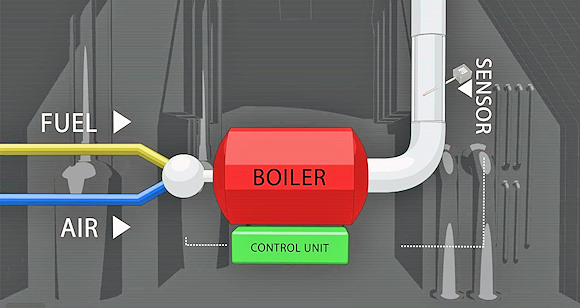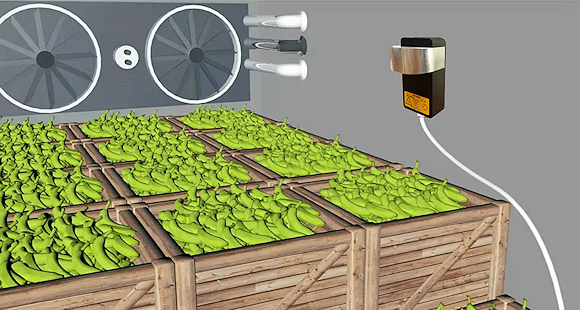
Accurately ascertaining oxygen levels is essential in many applications within the industrial, agricultural, storage/transportation, automotive, and medical sectors. While the scope of these applications is expanding, the performance requirements continue to rise.
According to Micromarket Monitor, the worldwide oxygen sensor business is predicted to be worth over $2.6 billion annually by 2022. If this forecast is demonstrated to be correct, it will mean that the market for such technology will have almost doubled in the course of a decade.
Key Oxygen Monitoring Applications
The following gives a brief snapshot of the variety of applications where establishing, and subsequently regulating, the oxygen level is vital.
Combustion Control - By monitoring the oxygen levels in the flue of industrial boilers (whether they are gas, oil or biomass fueled), it is possible to determine the amount of excess oxygen in the exhaust gas. This is illustrated in figure 1.

Fig. 1: Example of a Boiler Control Application
While there must always be some excess oxygen in the flue in order to avoid the production of harmful carbon monoxide, excessive amounts indicate that the boiler is heating fresh air and therefore expending energy unnecessarily. Using this excess oxygen data, the fuel/air ratio can be adjusted so that a 'sweet spot' is reached, where combustion is carried out at its most economical and with as little pollution as possible, thereby enabling energy savings to be realized and also lowering the ecological impact.
Next page
Preservation of Perishable Goods - The presence of oxygen contributes to the degradation of organic materials (such as fruit and vegetables). By lowering the oxygen levels present in refrigerated freight containers and storage facilities, it is possible to prolong the commercial worth of these products while they are being transported or stored. This is described in figure 2.

Fig. 2: Example Controlled Atmosphere Application
Fire Prevention - In server rooms, document archives and even in warehouses where precious historical artefacts or paintings are being kept, fire is a great risk and the consequences of an incident could be catastrophic, both in terms of safety and loss of valuable property/data. In such cases, particularly where personnel are not generally working in the area concerned, creating a hypoxic (low-oxygen) environment is the most effective preventative measure. By using oxygen sensors to control nitrogen generators, it is possible to lower the partial pressure of oxygen in the area to a level where humans are able to work, but the outbreak of fire is virtually impossible.
Altitude Training - In the sporting world it has long been recognized that acclimatization to high altitude conditions can markedly boost athletes' performance. It means that athletes' bodies adapt to the reduced oxygen levels, through increasing the mass of red blood cells and hemoglobin, as well as an altering of their muscle metabolism. When these athletes participate in events at lower altitudes, they will benefit from a higher concentration of red blood cells for 10 to 14 days, thus giving them a competitive advantage.
Relocating to high-altitude training facilities is often impractical though. An alternative solution is to train in altitude simulation rooms or tents where the partial pressure of oxygen is reduced to the levels experienced at high altitude. Once again, oxygen sensors controlling nitrogen generators enable high-altitude environment replication.
On Board Inert Gas Generation (OBIGG) - As airliners burn fuel, the mixture or air and fuel vapors in the head space of their fuel tanks represents a potentially explosive environment. To mitigate the possibility of mid-air explosions, most modern airliners are now equipped with OBIGG systems.
Low-pressure air from outside the plane is compressed and most of the oxygen removed using a variety of different technologies. The remaining gas, which is predominantly nitrogen and is therefore inert, can be used to fill the fuel tank head space. The risk of fire and explosion is eliminated. Oxygen sensors provide the means of control for the whole process.
Elsewhere oxygen monitoring can be used for reducing the output of nitrogen oxides (NOx) in industrial plants and for examining the output emissions when vehicle testing is done. It is also beneficial in agriculture to boost crop production (for example, in the growth of mushrooms), as well as to accelerate compositing.
Next page
Zirconia Oxygen Sensors
Oxygen sensors based on zirconia (ZrO2) are highly suited to use in all of the above applications. They typically use one of two different sensing mechanisms in order to determine oxygen levels. These mechanisms are categorized as follows:
-
Oxygen Ion Pump Sensors - At temperatures above +650°C, ZrO2 partly dissociates, producing mobile oxygen ions within the material. Normally moving at random within the crystal lattice, these ions can be steered through the piece of ZrO2 when a DC voltage is applied across the material. This liberates an amount of oxygen at the anode proportional to the charge transported, which is referred to as an electrochemical pumping action.
A number of sensors on the market exploit the rate of oxygen ion pumping to infer the oxygen. However, they rely on small capillary holes which are prone to clogging in 'dirty' applications (where there is an increased volume of larger particulates present) and are very temperature sensitive.
- Nernst Effect Cells - Again, at temperatures above +650°C, when there is an oxygen pressure difference across a piece of ZrO2, a voltage (the Nernst voltage) is generated across it, which is proportional to the ratio of the partial oxygen pressures on either side of the material. The effect is extremely temperature dependent and usually requires a known reference gas to be available, which, in many applications, is impractical
As one example, sensors produced by SST employ both sensing mechanisms simultaneously rather than using one or other. The sensing cell operates by successively pressurizing and evacuating a sealed chamber between two pieces of ZrO2 using the principle of oxygen ion pumping. At the same time, the pressure change is monitored using the Nernst effect. The time taken to achieve the desired pressure changes is directly proportional to the oxygen partial pressure of interest.
As a result the Zirconia sensors deliver functional benefits:
- They do not require access to a reference gas, meaning they can be applied to a much broader array of applications.
- The dynamic operating principle (with simultaneous ion pumping and Nernst measurement) results in a cyclical output waveform. This 'heartbeat' signal allows sensor health to be monitored continuously and is one of the reasons why these sensors are often used in safety critical applications.
- SST's dynamic cell exhibit greatly reduced temperature sensitivity, avoiding the need for costly temperature control of the cell.
The devices can handle vibrational forces up to 20g and have a normal working temperature range spanning from -100°C to +400°C. Thermal management of the gas stream to the sensor allows users to extend the allowable gas temperature to over 1000°C. They offer lifespans of up to 10 years and are available in compact form factors.
Conclusion
As we have seen, oxygen monitoring system implementations can be used for many different purposes and each will have its own specific characteristics and numerous related technical issues to overcome. By working with an experienced oxygen sensor manufacturer with an extensive range of product options, it is possible to find the best fit and also benefit from their in-depth application knowledge in order to implement a sensing system that is fully optimized for the required task.
About the Author
Andrew Cumming has worked at SST Sensing's headquarters in Scotland for two years in the role of Sales Engineer. After studying Electronic Engineering at Glasgow Caledonian University, his career began in the semiconductor industry, working for a leading chip manufacturer. He has over a decade's worth of experience that has predominantly focused on providing first rate technical support.
Related Stories
The gas sensor market is about to change
R&D Efforts Growing Portable Gas Detector Markets
Gas Detection Equipment Market to hit US$5.6 Billion by 2024
Partners Develop Wearable Wireless Biosensor Platform That Frees Patients From Cables